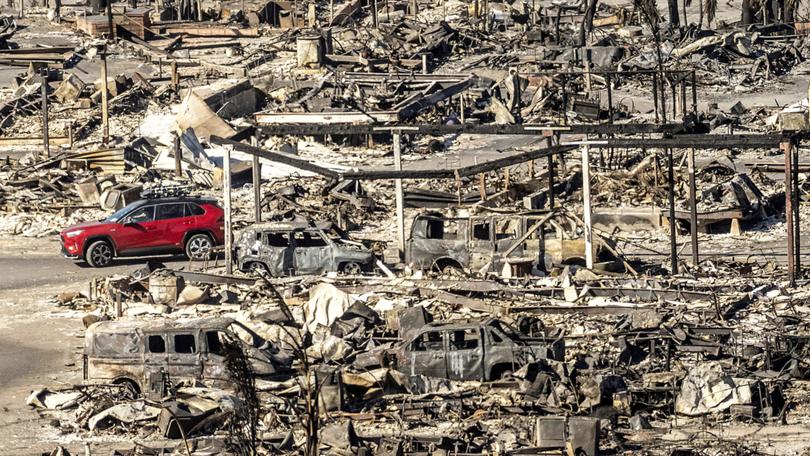Los Angeles fire health risk: Cancer-causing chemicals may now be in drinking water, warning issued

The Los Angeles Department of Water and Power and parts of Los Angeles County have issued “do not drink” and “do not boil” notices to residents in the Palisades, Altadena and neighbouring communities.
Wildfires that encroach into cities risk introducing harmful chemicals otherwise known as volatile organic compounds (VOCs) into the municipal water system.
Experts say it will take weeks for these utilities to determine the extent of any contamination and months before remediation takes place.
Sign up to The Nightly's newsletters.
Get the first look at the digital newspaper, curated daily stories and breaking headlines delivered to your inbox.
By continuing you agree to our Terms and Privacy Policy.Until then, drinking, bathing or using tap water in these areas could have untold health consequences.
Why are there ‘do not boil’ and ‘do not drink’ notices?
In other natural disasters like floods or earthquakes, city officials may recommend boiling water before using it. Breaking of pipes or inundation in those situations might introduce harmful bacteria or viruses, harming drinking water.
Boil notices are for killing bacteria. VOCs are chemicals. As Andrew Whelton, a professor of civil engineering and ecological engineering at Purdue University puts it, “Chemicals can’t be killed. You have to physically remove them from the water.”
When there is a “do not boil” or “do not drink” warning, the utility suspects that VOCs may be present in the drinking water.
In notices to communities, water utilities emphasize that “boiling, freezing, filtering, adding chlorine or other disinfectants, or letting water stand will not make the water safe.”
If residents detect any odour or off colour in their tap, they should inform their water utility.
Mr Whelton says that after the Tubbs and Camp fires, all it took was one person to report an odd taste that drew attention to wider testing of Santa Rosa County’s water supply.
What are VOCs, and how can they get into water systems?
Melted and heated plastics and fumes that enter the water pipes can bring dozens of VOCs into the plumbing. Benzene - a known carcinogen regulated by the Environmental Protection Agency - is a common chemical found after contamination.
It is not the only VOC that might be present. Toluene, xylene, vinyl chloride and dichloroethane are among many compounds produced from burned consumer products and building materials that should be tested and removed to safe levels before water is safe for drinking again.
When buildings burn and the ground is superheated by wildfires, VOCs can enter water utilities in two ways:
- The degrading of PVC or other plastic materials used in plumbing leaches chemicals into the system.
- Drops in water pressure from broken water lines or usage by firefighters can pull smoke, gases, and chemicals into the pipes.
Particularly in seismically active areas like Los Angeles, where PVC and other plastic piping is often used for plumbing for its flexibility, VOC exposure is greater. Multiple studies and water tests at the time from 2017 and 2018 from the Tubbs and Camp fires in California showed high levels of contamination for months after the wildfires.
Even if a home was spared from the recent fires, it does not mean the water system was. Depressurization from the utilities results in VOCs entering plumbing beyond the fire’s extent.
Mr Whelton has worked with the communities after the deadly Camp and Tubbs fires and more recently the Maui fires in Lahaina, Hawaii.
He offers residents and utilities free guidance on treating their water systems post-fire.
When the drinking water supply is compromised, VOCs can enter the body through ingestion, skin contact or inhalation, Mr Whelton says.
When you cook with water with VOCs or take a hot shower, you risk aerosolizing those harmful chemicals, which can damage your health in the short and long term.
Exposure could lead to acute vomiting, an accelerated heart rate, irritation of the stomach, dizziness and convulsions. Long-term health outcomes from exposure to VOCs include cancer, anemia, neurological effects and damage to the reproductive system and fetal development, according to public health scientists.
How do VOCs get out of the water system?
The continued fires and their damage to infrastructure may elude utilities and experts for now.
Newsha Ajami, a hydrologist and the chief strategic development officer for research in the earth and environmental sciences area at Lawrence Berkeley National Labs, says that municipal water treatment is not designed to handle this level of infiltration and it is impossible to know the extent of contamination at this point.
Attempting to filter the water at home will not prevent VOC exposure. “Don’t go out and buy whole-house filters … even though a company may charge you $10,000 and let you back in your home,” Mr Whelton says.
For drinking, cleaning or making formula, it is best to contact the utility or first responders for bottled water.
In the coming weeks, the cities and counties will be able to get a sense of the scale of damage, but it will take months to test and flush out harmful chemicals from these systems. Checking water quality from the treatment centres to the neighbourhoods along the existing pipelines will have to happen at every juncture to ensure VOCs are emptied out.
Corroded, melted pipes need to be inspected thoroughly. Even if they show no cosmetic sign of wear, superheated plastic can still leach VOCs back into the water.
Testing water from your tap one time is useless, cautions Mr Whelton.
As he saw at Lahaina and with the Camp Fire in Paradise, California, residents used testing that costs hundreds of dollars and only yielded ephemeral readings.
“I strongly encourage people not to rely upon their own ability to treat the water,” Mr Whelton says.
A single result will not inform a resident of the dozens of VOCs that may be there or present later in the day or coming weeks.
It will take a concerted effort from first responders, communities impacted, utilities and local officials to restore confidence in the drinking water.
Ms Ajami says anyone trying to re-create the same buildings and infrastructure should not expect a different outcome.
“These disasters are heart-wrenching to watch … all the people who have been impacted and communities displaced,” Ms Ajami says.
She adds: “It will take a degree of rethinking how these communities are rebuilt. There’s no going back to what we have done before.”
© 2025 , The Washington Post
